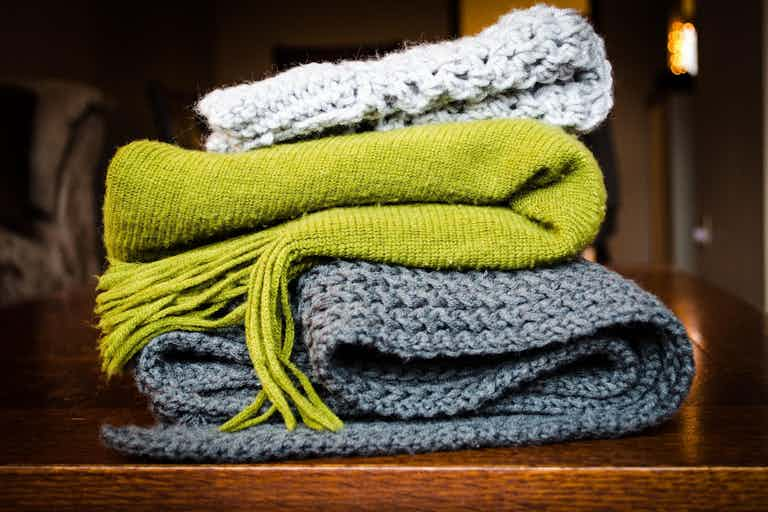As winter well and truly gets underway, it’s a good idea to start thinking about ways to keep warm when the temperature begins to plummet. According to the NHS, people aged 65 and over are most at risk from the effects of cold weather, so it’s essential to wrap up warm and find ways to keep your body temperature from dropping too low.
To help you out, we’ve put together a list of top tips for warming up that don’t involve just whacking the heating up! So follow our guide to keeping warm if you want to feel cosy and keep yourself healthy without spending a fortune on heating bills.
Keeping the house warm
To start with, we’ve got a few easy ways to warm up your house or home during the winter months.
Block out draughts
If your home is draughty, now is a good time to do something about it. Draughts let cold air in and can make it feel like the whole house is freezing. Luckily, there are some simple ways to remedy this and block out drafts.
Buy draught excluders and place them at the bottom of closed doors. They’re inexpensive and can help block out any breezes that waft through under your living room door. If you’ve got grandkids coming over, you can even buy draught excluders that are shaped like animals to keep things looking friendly and welcoming.
For your windows, we recommend buying some draught-excluding tape. It’s a cheaper (and much easier) alternative to replacing the caulking around your doors and windows. Simply unroll and attach wherever you feel a draft coming through. It couldn’t be easier.
Insulate your house
Insulating your house is essential for keeping the warmth in and the cold out. You can purchase and install several cheap items to ensure your home isn’t losing too much heat.
Loft insulation is cheap and easy to install, and it can make a huge difference. Not only will it prevent heat loss through the roof, but it could also save you money on your energy bill, meaning your winter fuel payment will be lower. It’s a win-win!
Another good option is buying and installing a thermal lining for your curtains. If you have old windows, it’s a great way to stop cold air from getting through to your home. We also recommend that you keep your curtains open during the day to let the warmth from the sun in. Keep them closed once that sun has gone in to trap any of that warmth inside.
Check your boiler and radiators
There’s no point in having the heating on or turning the thermostat up a couple of degrees if your boiler and radiator aren’t working as well as they should be. So with that in mind, remember to have your boiler regularly serviced to make sure it’s working well. It’s also a good idea to bleed your radiators before winter.
You can also buy a reflective panel or a heatkeeper to install behind your radiators. This is especially useful if your radiators are underneath windows.
If you’re using the heating often, check to see if you’re eligible for the UK government�’s Winter Fuel Payment or Cold Weather Payment.
Use the oven wisely
Cooking is a great way to warm up the kitchen, but once you’ve finished preparing your meal, you’re probably just switching off the oven and leaving it at that. Instead, when your meal is ready, turn the oven off but open the door. The residual heat from the oven will spill out into the kitchen to warm it up even more. Since you’re using the oven anyway, it’s much more energy-efficient than a space heater!
Keeping yourself warm at home
When the weather really starts to get cold – we’re talking sleet, snow and blizzards – there are some additional ways you can keep yourself toasty while you’re at home. Taking steps to warm up your body rather than the whole house can save you money on your heating bills.
Optimise your bedroom for warmth
You can do a few things to keep yourself warm during cold winter nights. First, we recommend investing in a thick winter duvet and a brushed-cotton duvet cover. This will instantly make your bed a lot cosier and help you stay warm all night.
If it’s really cold, get a couple of hot water bottles ready before you go to sleep. Put one at the bottom of the bed to warm up your feet, and have one with you to hug throughout the night. A heating pad is a good alternative if you don’t like hot water bottles.
Finally, we recommend buying some cosy winter pyjamas. You could even wear thermal underwear underneath them for an extra layer of warmth for the coldest nights.
Invest in the right gear
You can buy a few other things for your home that will help keep you cosy. Snuggling up under an electric blanket is a great way to stay warm. Just remember to never use them at the same time as a hot water bottle, as there are safety risks involved. If you go to bed with a hot water bottle, it’s better to keep your electric blanket in the living room on the sofa instead.
Drape regular blankets over the sofas to add an extra layer of cosiness between you and the couch material. We also recommend wearing fluffy socks and warm slippers while you’re indoors, particularly if you have a tiled floor.
Eat and drink smart
Eating hot meals is a great way to warm up. Instead of colder dishes like salads or room-temperature sandwiches, cook yourself something hot for lunch and dinner. Soups, stews, casseroles, pies and mash, porridge… they’re called winter warmers for a reason! Try some new recipes or make the most of winter ingredients.
If you have the heating on a lot, your home can become very dry, so staying hydrated in the winter is important. Hot chocolate, cups of tea or other hot drinks are a great way to hydrate and warm up at the same time. We recommend avoiding alcohol (well, most of the time!). A glass of wine or two might make you feel a little warmer or more flushed in the short term, but alcohol actually prevents your blood vessels from constricting, meaning it can actually lower your body temperature in the long run.
If you do fancy a little snifter of something, hot alcoholic drinks are the way to go. Try a glass of mulled wine, some hot buttered rum or a hot toddy.
Trick your brain
We spoke to Clare Kirby from Life, Love and Dirty Dishes, who told Age Times: "I would add that choosing cosy and warm lighting can really make a difference in a room feeling warmer. Maybe a few candles. Whilst it's not physically warming a space, lighting and decor can help to create a feeling of warmth."
Staying warm while you’re out and about
Keeping warm when you’re out of the house is obviously very difficult sometimes. There’s no warm air, so you can quickly lose body heat. So on the coldest days, it might just be best to stay indoors. But if you do head out, follow these tips for staying cosy.
Dress in layers
It might sound obvious, but dressing in layers is absolutely essential for keeping warm on the go. And we don’t just mean wearing a coat! Here are some easy tips for layering up that you might not have thought of.
If you wear skirts or dresses, wear thick woollen tights underneath. You can also wear tights like this under jeans or trousers if it’s really biting out. We also recommend wearing thermal underwear or leggings underneath your tights for an extra layer.
Long johns and long thermal underwear might have gone out of fashion a bit, but it really is still a fantastic way to warm up while you’re out in the cold. Wear a long-sleeved top or a thermal vest under your top, and layer up even more with a jumper and a cardigan under your coat.
It’s also a good idea to take off the outermost layers when you’re inside so you can really feel the benefit when you’re ready to head back out.
Remember your hat, scarf and gloves!
These items are absolutely essential for keeping warm in the winter. You’ve probably heard that we lose most of the heat from our bodies through the tops of our heads. This is really just an old wives’ tale, but most of us will at least feel colder if our heads or ears are chilly. To remedy this, keep your bonce warm with a lovely woolly hat.
If you find gloves cumbersome or inconvenient to wear, try a fingerless pair, or invest in a pair of arm warmers instead.
Take a hand warmer with you
Hand warmers are a fantastic way to keep your hands toasty if you’ve not got a pair of gloves with you. They’re small enough to fit in your pocket and are reusable. Simply click and hold to feel instant warmth spreading through your fingertips… Bliss!
You can buy rechargeable electric hand warmers or camping-style hand warmers – you can recharge this type by placing it in boiling water for a few minutes.
Keep moving
It’s essential to keep your body moving regularly if you want to stay warm while you’re outside in the cold air. Walk around briskly and try to keep your heart rate up as much as you can. This will boost your circulation, which is the key to feeling warm all over.
If you’re seated outside rather than walking around, try to move your legs every now and then. You might look like a bit of a fidget, but it’s worth it if it’ll keep you warm!
Keeping warm in the colder months
It can be difficult to stay warm when the weather changes, but with these simple tips and suggestions, you should feel toasty whether you’re indoors or out and about. And don’t forget, you can always keep






